Power stations have been around for over 15 years now. It’s been really cool to see how the technology has improved over the years.
Power stations are now more portable, user-friendly, and reliable than ever. They’ve also gotten much cheaper, so buying a power station for disaster preparedness or off-grid living is within reach.
Bluetti is a newer brand of power stations, formed in 2019 as part of a crowdfunding project. They immediately got attention as one of the first brands to use LiFePo4 battery technology and MPPT solar charge controllers.
I was lucky enough that Bluetti sent me one of their power stations and solar panel sets to try out. Here’s my full review and verdict.
Our Verdict:
The Bluetti EB70 is great because it is completely idiot-proof. Even if you have zero experience with power stations or solar panels, you will be able to figure out how to use it.
The real value, though, is in the LiFePO4 battery technology that Bluetti uses: it has a much longer life cycle than the Li-ion batteries used by most other brands. This makes the EB70 a great value, and you can count on it to perform well for decades.
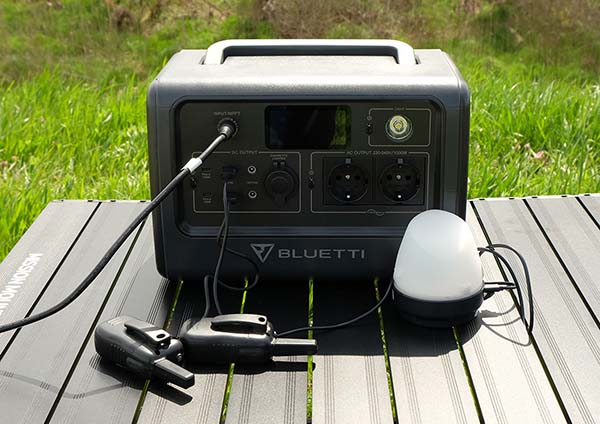 BLUETTI EB70S
BLUETTI EB70S
The EB70 power station + PV120 solar panel setup is great for disaster preparedness and could also be useful for camping, RVs, or off-grid living. Just don’t count on it to power energy-hungry appliances like refrigerators, fans or heaters.
Also read:
EB70S Power Station Quick Specs:
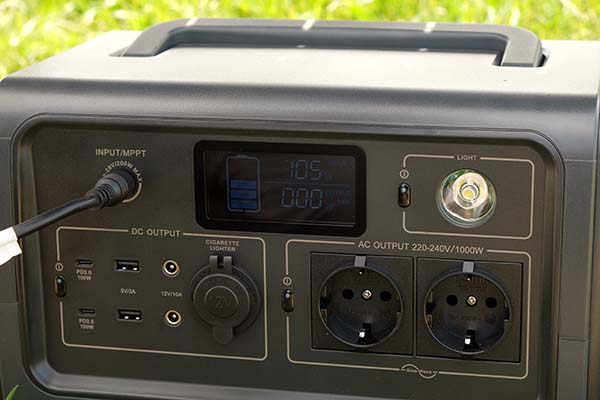
- Capacity: 716Wh
- Battery Type: LiFePO4
- Lifespan: 2,500 cycles to 80% original capacity
- Outputs: 4xAC (120V/20A); 2xUSB-A (5V, 3A); 2xPD USB-C (100w); Wireless charging (15w); 2xDC (12V, 10A); 1xDC car outlet (12V, 10A)
- Peak Wattage: 800W (1400W surge)
- Input: Solar input (200w max); AC adapter (200w max,VOC 12-28V, 8A); 12/24v from cigarette lighter port
- Weight: 21.4lbs
- Size: 12.6×8.5×8.7″
Note: These are the specs for the US version (EB70S) power station. I have the European EB70, which only has two AC outlets. The EB70 has a peak wattage of 1000W, whereas the EB70S has 800W.
PV120 Solar Panel Quick Specs:
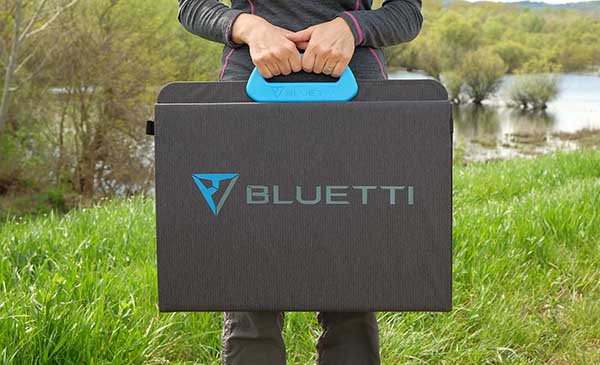
- Peak Power: 120W
- Weight: 12.6lbs
- Folded Size: 21×18.5″
- Unfolded Size: 21×65″
- Cable Length: 9.8 feet
- Cell Type: Monocrystalline silicon with ETFE lamination
- Efficiency: 23.4%
- Max Current and Voltage: 6.1A and 19.6V
- Open Circuit Voltage: 24.4V
- Short Circuit Current: 6.43A
- Connector Type: MC4
What Can You Charge with the EB70 Power Station?

The EB70S power station has 11 outlets (my European EB70 version has 9) plus wireless charging. This allows you to charge pretty much any small device or appliance.
Most of my devices are charged by USB, so I’m using those two outlets the most. But it’s also nice that there are DC outlets, two PD USB-C outlets (great for laptops that use them), and standard AC wall outlets.
How long can you run devices on the EB70S?
The EB70S has a battery capacity of 716Wh. This is pretty large for a portable power station, so you can run small devices off of it for a very long time. This makes the EB70S great for phones, USB lights, emergency radios, and other devices you might need during a power outage.
Let’s take an example: A typical cell phone battery is approximately 2500mah. Operating at 5V, this equals 12 watt-hours of energy. Even when factoring in some power loss, you should still be able to recharge your phone 45-50 times.
The EB70S has a max power output of 800W. This means you can charge multiple devices simultaneously if they don’t exceed 800W.
What about running larger devices and appliances on the EB70S?
Let me start by saying that no portable power station is great for running power-hungry appliances like refrigerators, heaters, stoves, or electric kettles. The EB70S is no exception. The 716Wh capacity would drain quickly when connected to anything with a big power draw.
For example, a 500W space heater would only run for a little more than an hour on the EB70S.
To figure out how long a device will run on the EB70S, use this formula:
716Wh × 90% × 90% ÷ Wattage of appliance ≈ Run time
So be realistic about what you can run on the EB70S. If you need to run large appliances, you will have to size up to a large power station such as the Bluetti AC200MAX power station which is 2,200W and has a capacity of 2,048Wh. But this model isn’t as portable (it’s nearly 62lbs) and is a much larger investment. If budget isn’t a concern, then you might even consider one of Bluetti’s home backup power stations.
Low Max Surge Power
The EB70S has a max surge power of 1400W. Surge power is the maximum amount of power it can handle at once for a short period. This is important because some appliances require a low of power to start up, even if they don’t require a lot of power to run.
Compared to other power stations with similar max power, 1400W surge power is fairly low. If you exceed this 1400W surge, the EB70S will automatically shut off and an alarm will sound.
This low surge level honestly doesn’t bother me. I don’t plan on ever running a power-hungry device on the Bluetti (I have a gas-powered stove, heater and RV fridge for emergencies). But, if you want to run a fridge, well pump, etc. on the Bluetti EB70S, you may need to size up.
 BLUETTI EB70S
BLUETTI EB70S
The EB70 power station + PV120 solar panel setup is great for disaster preparedness and could also be useful for camping, RVs, or off-grid living. Just don’t count on it to power energy-hungry appliances like refrigerators, fans or heaters.
Wireless Charging:
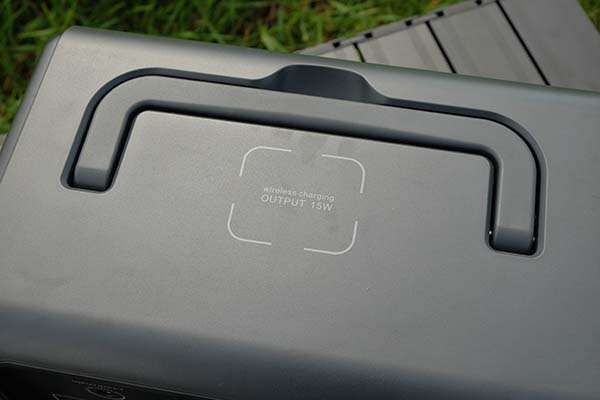
A nice feature of the EB70S is the wireless charging. Just put your device on top of the power station, and it will charge. You can only charge one device at a time. I don’t have any devices that use wireless charging (my phone is old!), so I haven’t tested this.
Note About the EB70S Inverter
The Bluetti EB70S has a built-in pure sine wave inverter. Pure sine is much better than modified sine inverters, thus making the EB70S good for powering sensitive devices. It also helps these devices work more efficiently.
Bluetti also uses MPPT charger controllers, which optimize the solar energy input to the battery. In short, the technology is much better than the competition.
Note: The built-in inverter will consume some energy when running or charging devices with the AC power outlets. For best efficiency, run devices off of DC power whenever possible. For example, many CPAP machines come with DC and AC plugs.
Ways to Charge with the EB70S Power Station
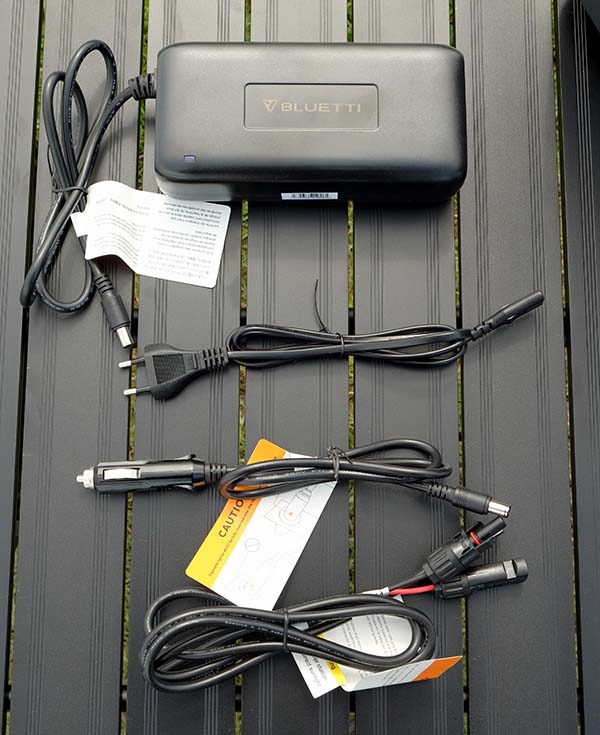
The Bluetti EB70 comes with three charging cables. This allows you to charge the power station in multiple ways:
AC Adapter Charging:
Use the power brick and connector to charge the EB70 from a standard wall outlet. It takes about 4 hours to fill the power station completely. You can also use this adapter to recharge the EB70 from a generator, meaning you don’t have to worry about running the generator near your home and potentially getting CO poisoning.
While this option is stupidly easy to figure out, note that the power brick is massive. It weighs approximately 2 lbs!
The power brick also gets hot while charging, which is why there is a built-in fan. There is also a fan in the actual power station. With both fans going, the noise can be loud (more on that later).
DC Cigarette Lighter Port:
You can charge the power station from anything which uses a cigarette lighter-type port. The obvious one is that you’d be able to charge the power station from your car.
However, there are some other power sources that have DC outputs. For example, a lot of pedal generators have DC ports. While I haven’t tried this, you could charge the EB70 with a pedal generator just by using the included cable – an excellent solution for disaster preparedness when solar charging isn’t an option.
At 12V, the power station will take approximately 7.5-8 hours to recharge. At 24V, it will take 4-4.5 hours.
Solar Charging:
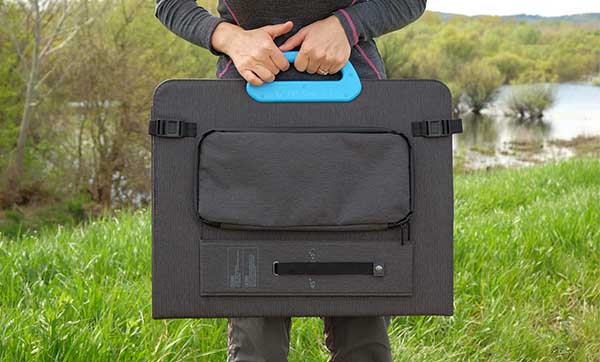
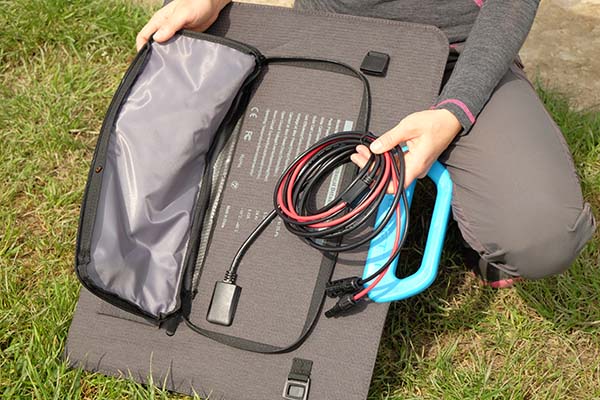
I got the PV120 with my EB70 power station. It has a zippered storage area in the back with a lengthy cable in it. Use the adapter that comes with the EB70S power station to hook it up.
Compared to the older SP solar panels by Bluetti, the PV solar panels work better in partial shade: only the shaded part of the panels will lose power. If half the solar panel is shaded, it will charge 50%. By contrast, the SP solar panels would lose a lot more power across the entire unit.
If you have any experience with solar panels, you know not to expect the advertised wattage. So, I have been pleasantly surprised at how well the PV120 panels performed.
The day I took these photos was a partially-cloudy spring day. Despite the sun not being intense, I was getting an average of 100W of power. It even got up to 117W at one point.
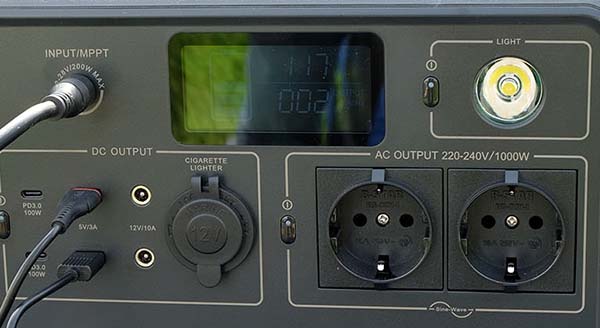
Be realistic though: even if you could get a full 120W from the solar panels, it would still take 8 hours to recharge the EB70S.
With the 200W solar panels, it would be 4 hours. But, again, that’s assuming you have full sun and regularly re-position the panels for optimal light exposure.
*You can use other solar panels to charge the EB70 power station. They must be open circuit voltage and between 12-28V. If your panels use an Anderson connector, you’ll need to buy an Anderson-to-MC4 cable.
Setting Up the PV120 Solar Panels
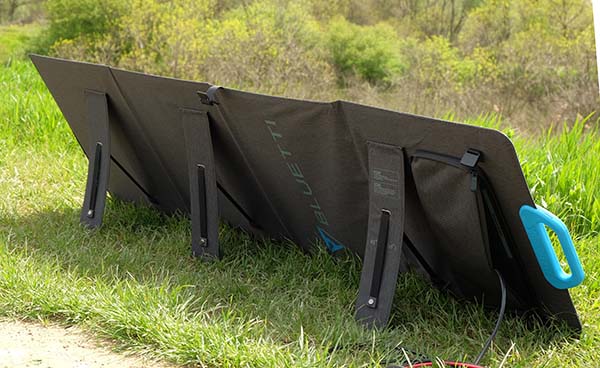
The Bluetti PV solar panels have built-in kickstands in the back. While these are a cool feature, I found them fairly useless in practice. While trying to set up one kickstand, the others topple over (it would be even more difficult with the large 200W panels).
They also easily toppled over in the wind. Oh, and adjusting the angle of the solar panels is impossible.
Bottom line: Don’t rely on the kickstands. Bring something to prop up the solar panels!
Simultaneous Charging and Discharging
For me, being able to charge and discharge simultaneously is a really important feature of the EB70 power station. Most good power stations have this capability (but not all!).
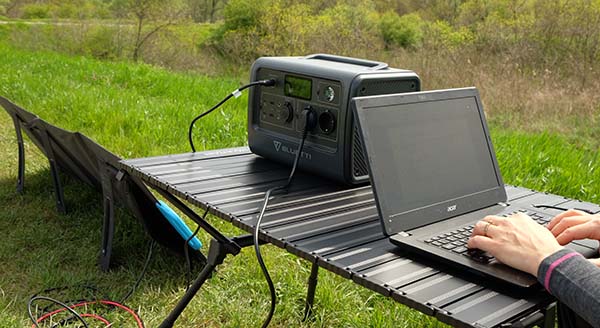
Weight and Portability of the Setup
I love the size of the EB70 power station. It is compact and doesn’t take up much storage space. I particularly love that the handle folds down into the unit. By contrast, the Jackery Explorer has an annoying molded handle on top, so you can’t even stack anything on top of it.
What I don’t like is the weight of the unit. It weighs nearly 22 lbs, and even more if you calculate in the AC charging brick. For disaster preparedness at home, the weight probably isn’t an issue. But I wouldn’t want to lug this to a walk-in camp.
The PV120 solar panel is even less portable. It weighs nearly 13 lbs and folds down to a massive 21×18.5 inches. The carrying handle does help, but be realistic about how annoying it would be to carry this anywhere.
Battery Technology
One of the main things that set Bluetti apart from the competition is that they use lithium iron phosphate (LiFePO4) technology for their batteries instead of Lithium-ion. Aside from being safer and withstanding high temperatures better, LiFePO4 batteries have a MUCH longer lifespan.
Because of the LiFePO4 technology, the Bluetti EB70 power station can go through 2,500+ cycles and retain 80% of its capacity. By contrast, Jackery power stations can only go through 500 cycles. In the long run, LiFePO4 power stations are a much better value.
The downside? LiFePO4 batteries are heavier than lithium-ion. They also take longer to charge and discharge. However, I’d choose longevity since power stations are so damn expensive.
Random Small Things I Like about the Setup
- Long Cable: The cable on the PV120 solar panel is nearly 10 feet long. This makes it easy to put the panels in bright sun while keeping the power station shady so it doesn’t overheat.
- Inlet and outlets on front: This makes it easy to plug the cables in without having to worry about accessing outlets on the side.
- Handles Temperature Extremes: The EB70 can be stored at 14-113 degrees F and operates at 14-104F. I’ll be using it in an unheated off-grid cabin and other outdoor situations, so it’s a huge plus. Just don’t leave it in a very hot car!
- Flashlight: I wouldn’t want to use this built-in light during power outages. But it could be helpful to turn it on while you set up your emergency lighting.
What I Don’t Like about the EB70 Power Station
- Display screen: In bright light, the display screen is very hard to see. The display also turns off quickly. This makes it very annoying when trying to orient the solar panels for optimal sunlight.
- Battery charge in 20% increments: The display will only tell you if the power station is 0%, 20%, 40%, 60%, 80% or 100% full. I’d prefer an exact measurement of capacity. Or at least in 5% increments!
- No app compatibility: A phone app would be useful for tracking the remaining battery capacity, solar charging, etc.
- Loud: When charging and discharging, an internal fan kicks on inside the EB70 power station. This one isn’t too loud. But the AC adapter brick also has a fan which is even louder. The combined noise is fairly annoying. The AC brick fan even keeps running for a while after disconnected.
- Not great for in-vehicle use: The vibrations from your vehicle can cause some of the cables to disconnect, which means the EB70 stops charging or discharging. So, I wouldn’t recommend this power station for van life.
 BLUETTI EB70S
BLUETTI EB70S
The EB70 power station + PV120 solar panel setup is great for disaster preparedness and could also be useful for camping, RVs, or off-grid living. Just don’t count on it to power energy-hungry appliances like refrigerators, fans or heaters.


I just got the Bluetti EB70s and the power was below 10 pct after one day of powering my surfboard modem and a flatscreen monitor….approximately 28 watts for both over 13 hours and 10 watts for the surfboard overnight….. perhaps an additional 12 hours. If my math is right that’s about 364 watt hours plus 120 overnight….. total of less than 500 watt hours used …. Plus about 75 watt hours still in the tank. Far less than the advertised watt hours …..I forget the exact spec but approximately 575/750 or about 77 percent of the advertised power. Is there an internal power draw sucking up 23 percent or any other logical explanation?
I wish I had read your review regarding the noise of the two fans and the size of the AC charging brick. Not necessarily a deal breaker but I might have looked at a couple other units more closely. I do like the surge specs on this fairly lightweight station.
Nice job writing a thorough summary. I found your info to be highly consistent with my initial impression. I may opt for something else for UPS …. due to the fan noise.